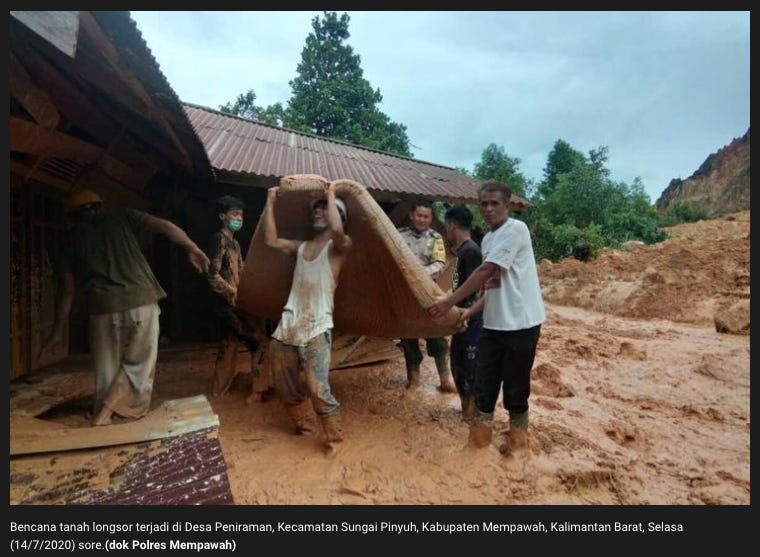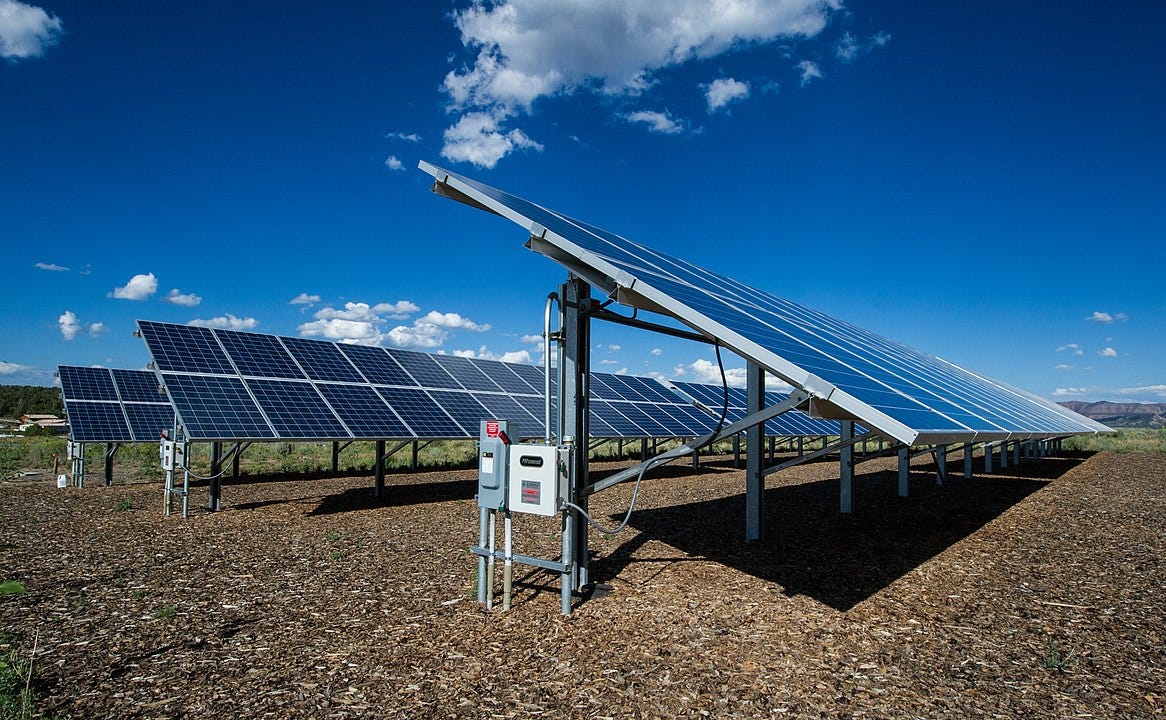Mines were outsourced. How are locals responding?
Part 2 of highlighting a key solar PV ingredient
Last week, I highlighted pivotal changes in mining bauxite, the unhatched form of aluminum. Remember ‘Sun, Smoke and Society’? If not, here’s a quick refresher.
China produces the majority of the world’s aluminum, but several years of tightening controls on air pollutants made Chinese companies scour the globe for more rocks to keep production strong. Companies have outsourced their mines around the world before, but observers didn’t think that was possible with bauxite.
Why we’re talking aluminum: The World Bank predicts that reaching clean energy by 2050 will require more aluminum than any other metal. The aluminum needed in clean energy may only equal roughly a tenth of today’s total aluminum production.
However, for the first time the mining companies have said they are vital to planetary health. Leveraging that branding presents the opportunity to ensure clean production across the board.
This week, we’ll look into how people around the world are responding to the ‘bauxite boom’ in their neighborhoods.
Let’s dig in.

Bauxite Mine in Brazil. (Norsk Hydro ASA via Flickr)
In March, in the midst of a global pandemic, a bauxite miner in Guinea relocated more than a 100 families. The community had agreed in 2015 to move away from mining activities, provided that there was adequate infrastructure and diverse jobs for them at the new location.
Representatives of the village had visited their new resettlement site late last year. The company, Compagnie des Bauxites de Guinée (CBG), listened as they requested improvements before they moved in.
The improvements hadn’t been made by the time they arrived. There is no topsoil to farm. The toilets are shallow and without privacy. CBG dug six wells, but residents have complained of limited water, and CBG denied requests to provide electric water pumps. Its independent environmental and social consultant found that land compensation was not reaching locals.
CBG claims the community representatives were included in a regular consultation process, and that they signed an agreement that complies with Guinean law. CBG is a joint venture between the Guinean government and three industry giants: US-based Alcoa, Anglo-Australian Rio Tinto, and private investment group Dadco.
The story above was detailed in a June report from the International Trade Center for Development, the Association for Rural Development and Mutual Aid, Inclusive Development International.

From a report from Inclusive Development International.
In the next five years, Guinea wants to become the ‘global capital of bauxite.’ The West African country is joining a number of areas preparing for incoming miners.
Guinea
After bauxite is mined, refineries extract alumina, and then another extracts aluminum. Guinea is on track to build up infrastructure for two alumina refineries. (Ten years ago, many couldn’t imagine a mine without a refinery next door.)
That requires a lot more energy. For a country with much of its population without electricity, the refineries may incentivize officials to electrify rural regions. Governments often want to encourage refining within their borders, as it requires much more labor and produces more tax revenue than exporting ore. These are the kinds of advantages that Patrick Heller told us about a few weeks ago, when he spoke on what mineral-led development looks like.
Guinea’s Minister of Energy & Water Resources, Cheick Taliby Sylla, tells Reuters: “Mines are, quite simply, development. And the mines can’t develop without energy.”
But it’s never that simple. A proposed hydroelectric dam, for example, is to power a refinery and may displace 15,000 people. When I was writing last week’s post, Cindy Wilhelm, a doctoral candidate at the University of East Anglia, reached out and pointed me in the direction of her research. She wrote in her master’s thesis on Guinea’s bauxite boom that
Despite its vast wealth of high quality bauxite deposits located in the Boké region, Guinea continues to be among the least developed countries and has been unable to benefit adequately from its resource abundance.


A year ago, a dozen villages, dismayed that large-scale protests had failed to stop bauxite mining, shifted their tactic. The villages filed a complaint to the watchdog over the World Bank’s International Finance Corporation (IFC), which had given CBG hundreds of millions of dollars to begin bauxite development. The villages argued that the IFC did not guarantee that CBG would comply with its sustainability principles, and the villages were left alone to fight the impacts of mining an area the size of downtown Chicago.
A few weeks before the villages were to begin mediation with the IFC’s watchdog, the 100 families moved to their resettlement site. Resolving the dispute has been put on hold during the pandemic.
Watch locals talk about the impacts of mining on their lives (Human Rights Watch)
Ghana
More than 100 countries include a ‘right to a healthy environment’ in their constitutions. Ghana is one of them, and last month, seven civil society groups argued that this right should prevent mining in the Atewa Forest Range, a globally significant biodiverse area.
China signed a $2 billion deal with Ghana two years ago to mine bauxite in exchange for building roads and bridges. Ghana Rocha, one of the groups involved in the case against the government, wrote that they weren’t opposed to economic development, but rather to forest destruction.
"Bauxite mining is a one-time payment. (The government) cannot bring back the original forest,” said Oteng Adjei, head of Concerned Citizens of the Atewa Landscape, one of the groups involved in the case.
Activists are arguing to give protected status to the forest, but bulldozers have already started.
Indonesia
While Guinea wants to move up the value chain and process the bauxite ore before it is exported, Indonesia aims to do the same, but it has taken a different path. Employing a characteristic tactic, it banned the export of raw bauxite. That was 2014, and three years afterward, the bid to encourage processing within its borders was deemed a failure.
But in the process, hundreds of mines were abandoned around Borneo, prime orangutan country.
Now, the government is giving it another go. Almost 100 mining licenses coat a single province in Borneo as the country prepares again to ban exports in 2022. This time seems more promising for industry, who have announced several new smelters. All depend on coal and diesel electricity, and community activists have accused some companies of clearing forests and taking ore without permits.
Last month, floods covered West Kalimantan province, and the governor hit bauxite mines with the blame. When soil is exposed, dirt flows into rivers, displacing waters and making it easier for heavy rains to cause flash flooding.

Flooding last month in Borneo. Police photo, from Kompas.com
Indonesia’s neighbor, Malaysia, lifted its ban on bauxite mining earlier this year, but there has been little information on which companies are to receive the first permits.
Industry
Industry players have generally chosen to address greenhouse gas emissions and air pollution. Red mud, erosion, groundwater depletion, and biodiversity impacts have received less attention.
A solar farm has for three years been powering bits and pieces of a colossal bauxite project in Australia. The mine, owned by mining giant Rio Tinto in Weipa, cuts down its diesel consumption during peak hours with the help of solar energy, but the capacity is still very small at only 1.7 MW.
But mines aren’t the biggest emitters in the chain; aluminum refineries are. The intense energy requirements mean that coal and diesel are still preferable.
In theory, it’s a cool idea — aluminum-consuming solar PV could cleanly fuel the creation of more aluminum. But what if we didn’t have to create more aluminum in the first place?
Recycled aluminum may have carbon emissions that are only a fraction of new aluminum. For some metals, recycling could make mining obsolete. The World Bank isn’t as optimistic for aluminum.
It predicts only 61% of aluminum demand will be satisfied by recycling in 2050. That figure relies on a hefty number of assumptions, most of which will not hold up. Consumption patterns could drastically change, or researchers could improve technologies to recover secondhand aluminum.

The goal. Wikimedia
I recommend this piece in Grist, which astutely highlights the importance in cleaning up the carbon emitted from processing aluminum. Below are some of the main points from that piece.
Many technology companies have released lofty climate goals, but few highlight low-carbon aluminum like Apple has. Emissions from the aluminum industry are so large they amount to their own category on global emissions tallies. It could be a whole percent of total global emissions. In 2015, aluminum made more than a quarter of Apple’s total manufacturing emissions.
Refining bauxite into aluminum typically releases carbon that’s trapped in the mineral. An Icelandic firm has developed a method to keep that carbon trapped. The technology’s impacts could be so great that the country’s total emissions could drop by a third if adopted, the company said. Emissions from powering the refineries, however, still make up 70% of the industry’s emissions.
This has been Green Rocks’ first excavation of a mining industry driving clean energy. I’d love to hear feedback!
Hi! I’m Ian Morse, and this is Green Rocks, a newsletter that doesn’t want dirty mining to ruin clean energy.
These topics are relevant to anyone who consumes energy. If you know someone like that, share freely! You can subscribe with just your email, and weekly reports with round-ups and original reporting will come directly to your inbox. It’s free! (for now)


